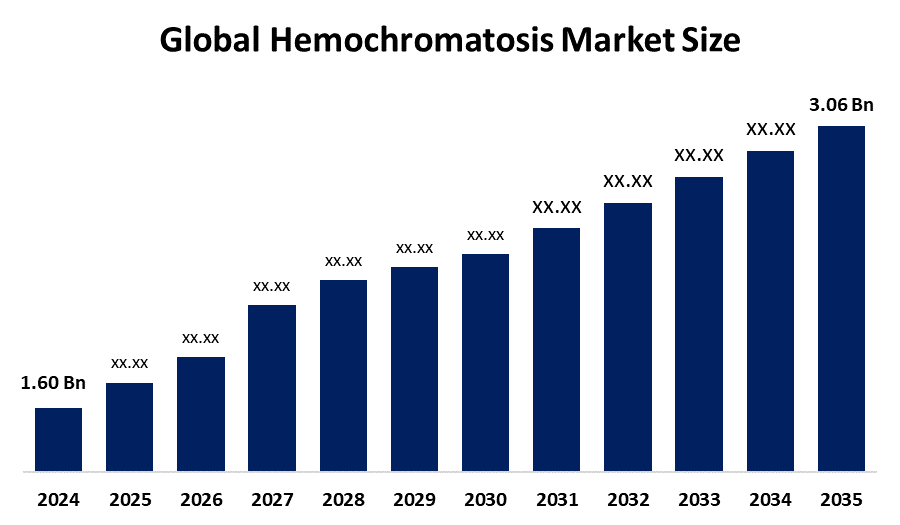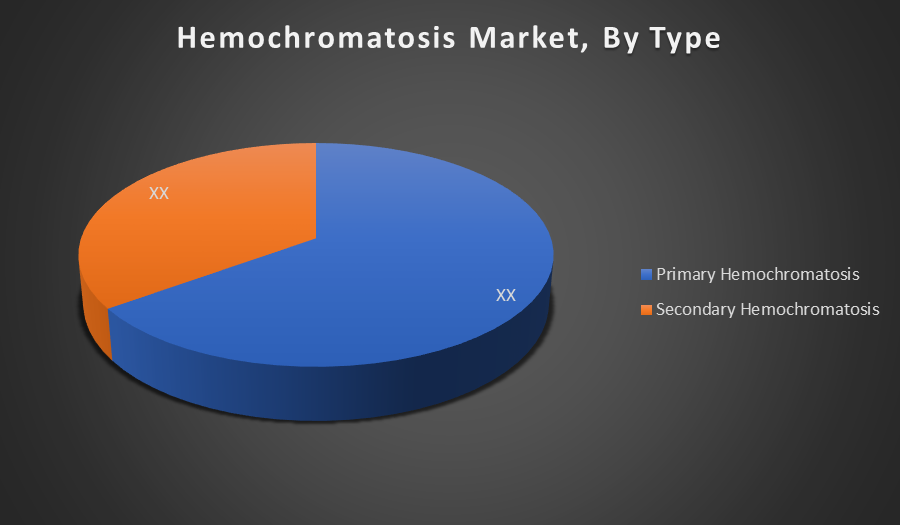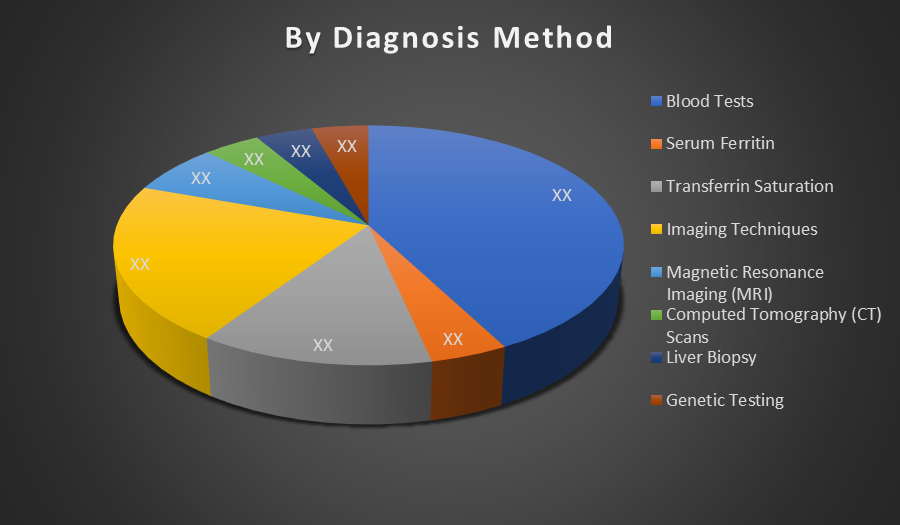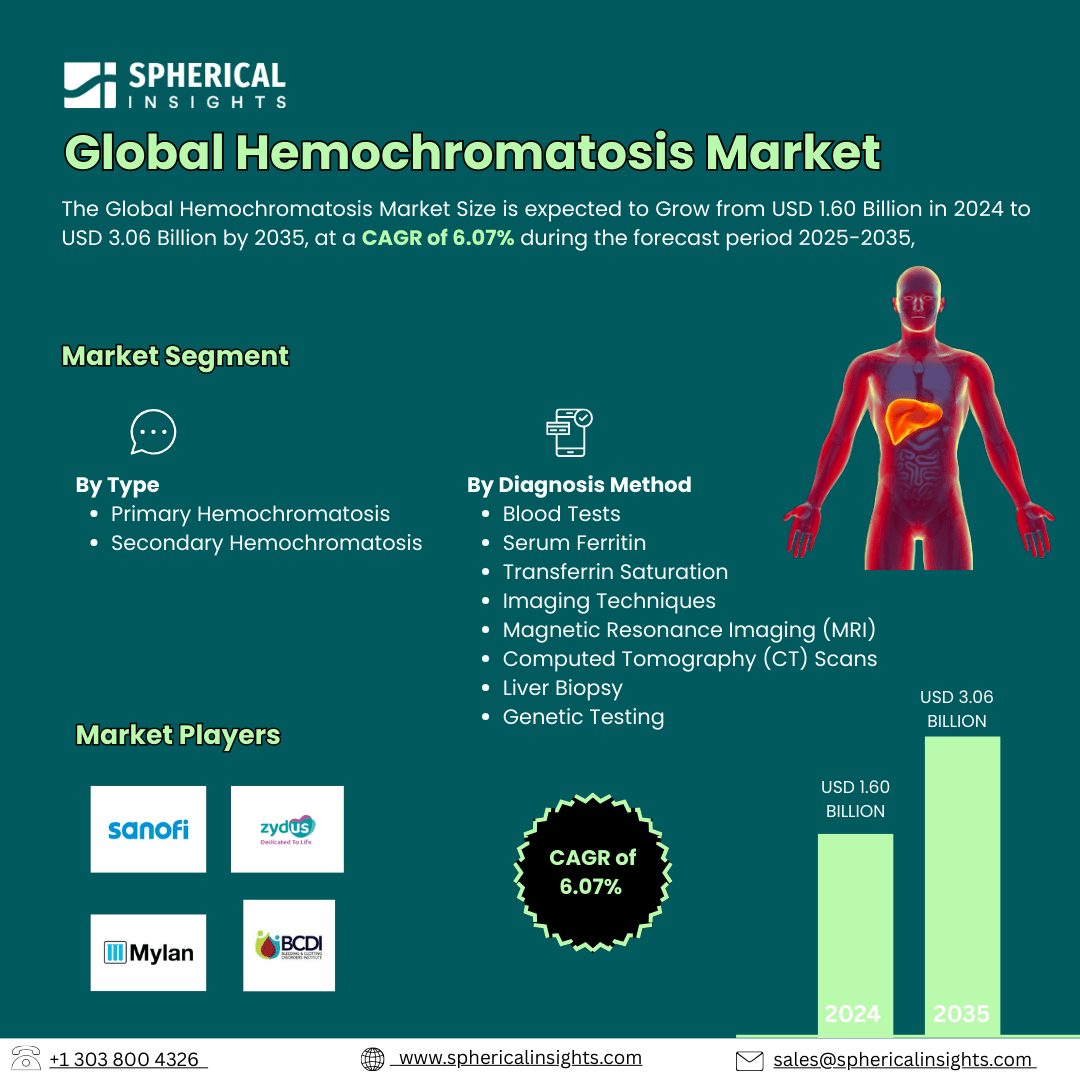- As per Spherical Insights & Consulting, The Global Hemochromatosis Market Size is expected to Grow from USD 1.60 Billion in 2024 to USD 3.06 Billion by 2035, at a CAGR of 6.07% during the forecast period 2025-2035, owing to the launch of new therapies in the market and the rise in the number of cases.
- The leading Hemochromatosis Market Companies such as Sanofi, Zydus Lifesciences, Pfizer, Mylan, Iron Disorders Institute, GlaxoSmithKline, Takeda, Teva Pharmaceuticals, Novartis, Sun Pharmaceutical, AbbVie, Apotex, Bayer, F. Hoffmann-La Roche, Cipla, and Others.

Hemochromatosis Treatment Market: Understanding and Treatment Algorithm:
Hemochromatosis is a genetic or acquired condition characterized by excessive iron accumulation in the body. If untreated, the iron buildup can damage vital organs like the liver, heart, and pancreas, leading to conditions such as liver cirrhosis, diabetes, and heart disease. Early diagnosis and treatment are essential to prevent complications.
Hemochromatosis Diagnosis:
Diagnosis of hemochromatosis involves blood tests to measure serum ferritin and transferrin saturation levels, which indicate iron overload. Genetic testing confirms hereditary forms, while imaging (MRI or CT scans) and liver biopsy assess organ damage. Regular screening is recommended for individuals with family history or symptoms of iron overload.
Hemochromatosis Treatment:
Treatment focuses on reducing iron levels in the body. Therapeutic phlebotomy, where blood is regularly removed, is the primary approach. In cases where phlebotomy is not feasible, iron chelation therapy is used. Lifestyle changes, such as avoiding iron supplements and limiting alcohol, support long-term disease management.
Hemochromatosis Epidemiology:
The disease epidemiology covered in the report provides historical as well as forecasted epidemiology segmented by Total Diagnosed Incident Population of Hemochromatosis, Gender specific Diagnosed Incidence of Hemochromatosis, Type specific Diagnosed Incidence of Hemochromatosis, Age specific Diagnosed Incidence of Hemochromatosis, Diagnosed Incident Population based on Primary Site of Hemochromatosis, and Diagnosed Incident Population based on Histologic Classification of Hemochromatosis Tumour in the global market covering North America, Europe, Asia-Pacific, Latin America, the Middle East, and Africa from 2024 to 2035.
Principal Insights:
This section offers a global overview of Hemochromatosis epidemiology in major markets worldwide.
Country Wise Hemochromatosis Multiforme Epidemiology:
- The epidemiology segment provides Hemochromatosis prevalence data and findings across key regions worldwide, including North America, Europe (Germany, France, Italy, Spain, and the United Kingdom), Asia-Pacific (including Japan), Latin America, the Middle East, and Africa.
Hemochromatosis: Recent Developments:
- In October 2021, Protagonist Therapeutics reported that findings from its open-label Phase 2 trial of rusfertide (PTG 300) in hereditary hemochromatosis were chosen for oral presentation at the AASLD annual meeting. The results showed notable reductions in phlebotomy requirements and improvements in iron-related parameters, underscoring rusfertide potential as a first-in-class therapeutic option.
Hemochromatosis Marketed Drugs:
• Exjade: Novartis
Exjade (deferasirox) is an oral iron chelator used to reduce chronic iron overload caused by blood transfusions in patients with conditions like hemochromatosis. It helps bind excess iron and facilitates its excretion through the body.
• Ferriprox: ApoPharma
Ferriprox (deferiprone) is an oral iron chelator that helps manage iron overload in patients who are unable to undergo phlebotomy, reducing iron toxicity and protecting organs from damage.
Hemochromatosis: Emerging Therapies:
- Rusfertide (PTG-300): Rusfertide is a novel peptide-based hepcidin mimetic currently in clinical trials for hereditary hemochromatosis. It aims to regulate iron absorption and distribution by mimicking hepcidin, reducing iron overload, and potentially decreasing the need for frequent phlebotomy.
- VIT-2763: VIT-2763 is an oral ferroportin inhibitor under investigation. It blocks iron release from cells, helping control systemic iron levels in patients with iron overload disorders like hemochromatosis.
Hemochromatosis Market Outlook:
- The Hemochromatosis market includes diagnostics and treatments for iron overload disorders characterized by excessive iron accumulation in organs. It encompasses therapeutic options like phlebotomy, iron chelation drugs, and advanced diagnostics, targeting hereditary and secondary hemochromatosis patients worldwide.
- Rising prevalence of hereditary and secondary hemochromatosis, increasing awareness about early diagnosis, advancements in diagnostic technologies, and growing adoption of iron chelation therapies drive market growth. The demand for non-invasive treatment options and increasing geriatric population also boost market expansion.
- Emerging novel therapies like hepcidin mimetics, expanding screening programs, and growing investments in rare disease research present growth opportunities. Increasing healthcare infrastructure in developing regions and rising patient awareness about complications offer untapped potential for market players.
- Governments worldwide support awareness campaigns, genetic screening, and rare disease funding programs to promote early diagnosis and treatment of hemochromatosis. Regulatory incentives for orphan drugs and reimbursement policies further encourage market development and patient access to therapies.
- Limited patient awareness and diagnostic delays hinder timely treatment initiation, affecting market growth.
- The market is projected to grow steadily due to increasing adoption of advanced therapies and improved diagnostic techniques, enhancing patient outcomes and disease management.
Hemochromatosis Market Segmentation:
By Type:
- Primary Hemochromatosis
- Secondary Hemochromatosis

Primary Hemochromatosis holds the largest market share due to its higher prevalence as a hereditary disorder causing excessive iron absorption. Early diagnosis through genetic testing and widespread awareness drives demand for its treatment, making it dominant compared to secondary forms linked to other diseases or conditions.
By Diagnosis Method:
- Blood Tests
- Serum Ferritin
- Transferrin Saturation
- Imaging Techniques
- Magnetic Resonance Imaging (MRI)
- Computed Tomography (CT) Scans
- Liver Biopsy
- Genetic Testing

The Blood Tests segment leads the market as the most commonly used, non-invasive, and cost-effective initial screening tool. Tests like serum ferritin and transferrin saturation are standard for detecting iron overload, prompting further imaging or biopsy, thus making blood tests the preferred diagnostic approach globally.
Regional Segment Analysis of the Hemochromatosis Market:
North America holds the largest share in the Hemochromatosis market due to strong healthcare infrastructure, widespread awareness, and early screening programs for hereditary conditions. The high prevalence of genetic testing and regular health checkups has supported early diagnosis and treatment. Additionally, favourable reimbursement policies, ongoing research, and the presence of major pharmaceutical players contribute to the region’s market dominance, ensuring better access to diagnostics and specialized therapies.
Asia-Pacific is the fastest-growing region in the Hemochromatosis market due to increasing healthcare investments, growing awareness of genetic disorders, and rising adoption of diagnostic technologies. Urbanization and lifestyle changes have contributed to a higher incidence of liver-related disorders, prompting more frequent screening. Government-led health programs and the expansion of diagnostic facilities are accelerating early detection and intervention, especially in developing nations like India, China, and Southeast Asian countries.
Hemochromatosis Market Key Companies:
- Sanofi
- Zydus Lifesciences
- Pfizer
- Mylan
- Iron Disorders Institute
- GlaxoSmithKline
- Takeda
- Teva Pharmaceuticals
- Novartis
- Sun Pharmaceutical
- AbbVie
- Apotex
- Bayer
- F. Hoffmann-La Roche
- Cipla
- Others
Hemochromatosis Therapeutics Market Report Scope:
- The Hemochromatosis therapeutics market report provides a detailed overview, covering its causes, symptoms, disease progression, and existing treatment options.
- Detailed insights into Hemochromatosis’s epidemiology and therapeutic approaches are included.
- Additionally, a comprehensive review of existing and emerging Hemochromatosis therapies is provided, including an evaluation of new treatments expected to influence the current Hemochromatosis treatment market landscape.
- The report includes a detailed review of the Hemochromatosis therapeutics market, both historical and forecasted, highlighting the global drug reach.
- The Patient-Based Hemochromatosis Market Forecasting report offers valuable insights into trends shaping the global Hemochromatosis market, helping to develop effective business strategies.
Hemochromatosis Treatment Market Report Insights:
- Forecasting Market Trends Based on Patient Data and Disease Rates
- Hemochromatosis Therapeutic Approaches in Hemochromatosis
- Review Of Drugs in Development for Hemochromatosis
- Market, Growth, and Trends in Hemochromatosis
- Market Opportunities in Hemochromatosis Treatment
- Effects Of Future Therapies on Hemochromatosis Treatment.
Hemochromatosis Treatment Market Report Key Strengths
- 15 Years Hemochromatosis Market Forecast
- Global Coverage
- Hemochromatosis Epidemiology Segmentation
- Key Cross Competition
Hemochromatosis Treatment Market Report Assessment
- Present Practices in the Hemochromatosis Treatment Market
- Review of Investigational Hemochromatosis Drugs
- Attractiveness of the Hemochromatosis Drug Market
- Hemochromatosis Market Drivers
- Hemochromatosis Market Barriers
- SWOT
- Attribute Analysis
Market Segment:
This study forecasts revenue at the global, regional, and country levels from 2020 to 2035. Spherical Insights has segmented the Hemochromatosis market based on the below-mentioned segments:
Global Hemochromatosis Market, By Type
- Primary Hemochromatosis
- Secondary Hemochromatosis
Global Hemochromatosis Market, By Diagnosis Method
- Blood Tests
- Serum Ferritin
- Transferrin Saturation
- Imaging Techniques
- Magnetic Resonance Imaging (MRI)
- Computed Tomography (CT) Scans
- Liver Biopsy
- Genetic Testing
Global Hemochromatosis Market, By Regional Analysis
- North America
- Europe
- Germany
- UK
- France
- Italy
- Spain
- Russia
- Rest of Europe
- Asia Pacific
- China
- Japan
- India
- South Korea
- Australia
- Rest of Asia Pacific
- South America
- Brazil
- Argentina
- Rest of South America
- Middle East & Africa
- UAE
- Saudi Arabia
- Qatar
- South Africa
- Rest of the Middle East & Africa






